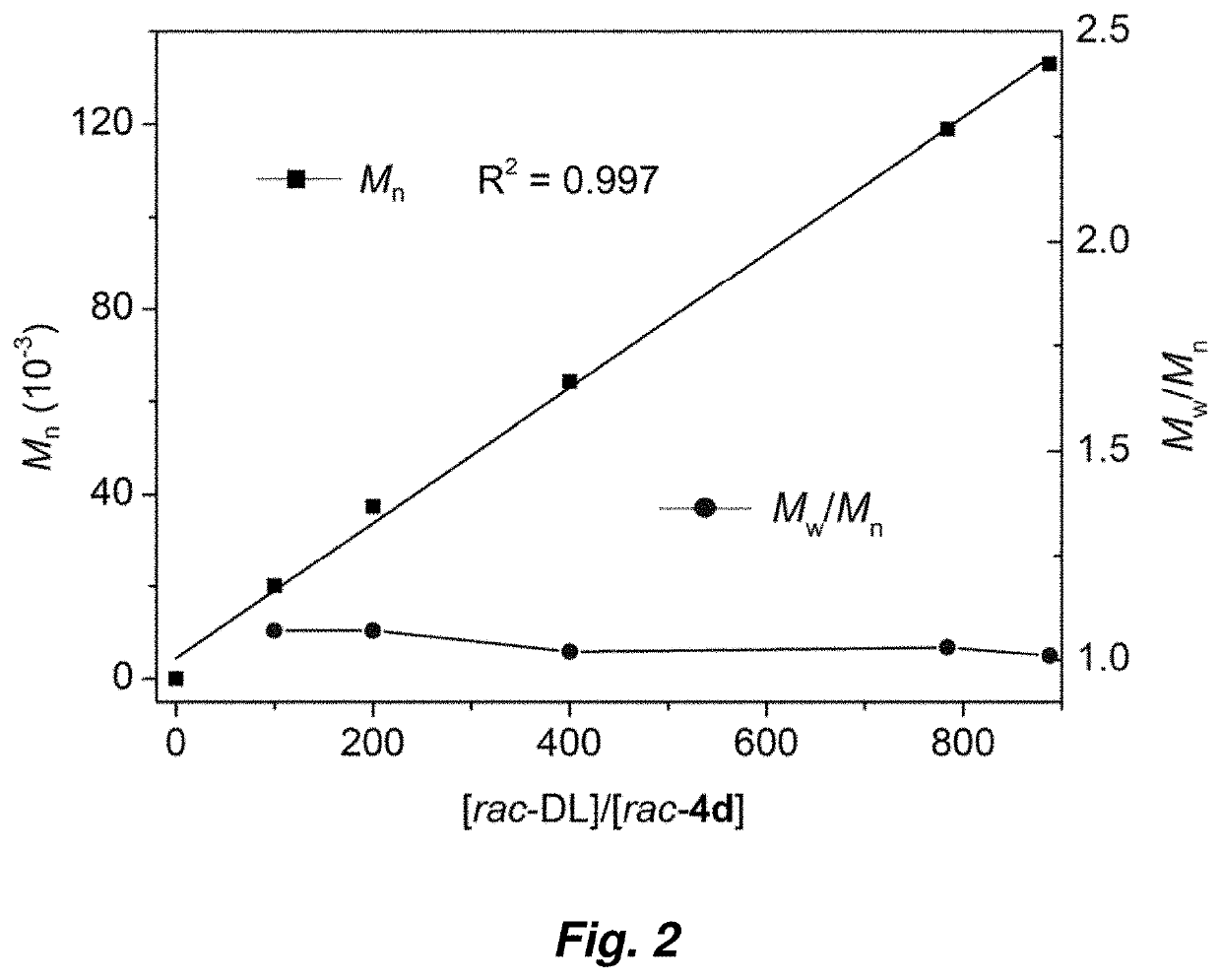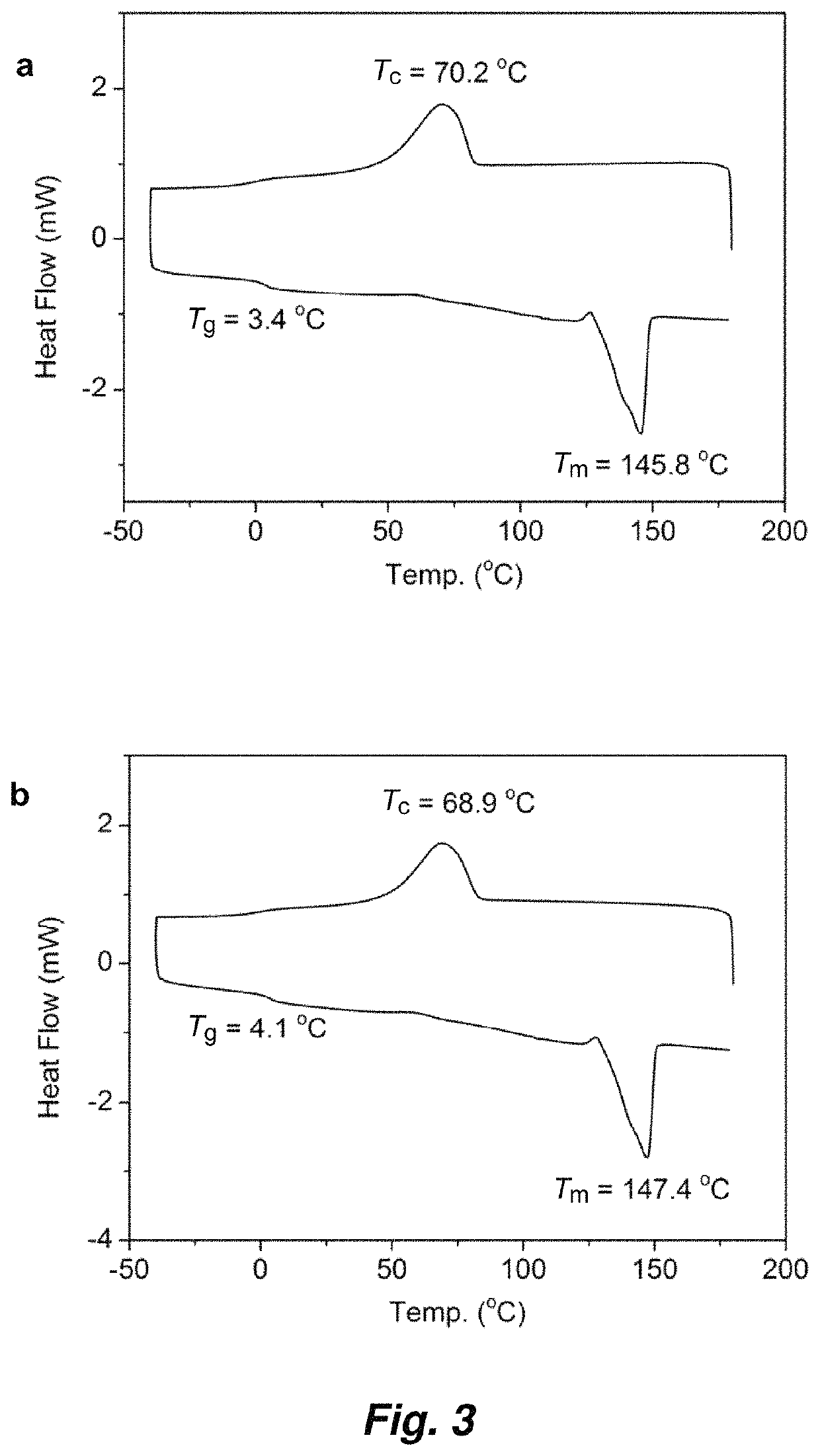Synthesis of crystalline polymers from cyclic diolides
a technology of cyclic diolides and crystalline polymers, which is applied in the direction of organic compounds/hydrides/coordination complexes, physical/chemical process catalysts, chemical instruments and processes, etc., can solve the high molecular weight and impracticality of commercial use for a synthetic equivalent of naturally produced p3hb to be commercially viabl
- Summary
- Abstract
- Description
- Claims
- Application Information
AI Technical Summary
Problems solved by technology
Method used
Image
Examples
example 1
of Racemic Eight-Membered Cyclic Diolide (Rac-DL)
[0268]The following illustrates a process for preparing a racemic eight membered cyclic diolide, rac-DL.
[0269]
[0270]Pure racDL can be synthesizes in a multi-gram scale from bio-sources dimethyl succinate as described below.
[0271]Typical diolides where prepared by adding a methyl group to structure (i) in Scheme 7 by deprotonation and addition of methyl iodide. As would be readily recognized by one of skill in the art, other diolides where R of Formula V, V-A, and V-B are (C1-C18)alkyl, (C1-C8)alkenyl, (C1-C8)alkynyl, benzyl, or aryl can be likewise prepared by addition of the appropriate iodide (or other halide) to deprotonated structure (i). Furthermore, diolides of the “DLα”-type can be obtained commercially or by the preparations known in the art.
Dimethyl 2,5-dioxocyclohexane-1,4-dicarboxylate (i)
[0272]A solution of sodium methoxide (185 mL, 5.4 M, 1.0 mol) was added to dimethyl succinate (73.1 g, 0.5 mol) in one portion, and the m...
example 2
of Yttrium Complexes 4a-c, and e
[0277]The following illustrates a process for preparing a racemic yttrium complexes 4a-c.
[0278]
Synthesis of Salicylaldehydes L2a-c
3,5-Bis(tert-butyl)salicylaldehyde L2a
[0279]2,4-Di-tert-butylphenol (30.45 g, 0.147 mol), 2,6-lutidine (6.9 mL, 0.059 mmol) and 100 mL anhydrous toluene were measured into a side-arm round-bottom flask under nitrogen. Tin(IV) chloride (1.72 mL, 14.7 mmol) was added slowly to the reaction flask. The mixture was stirred at room temperature for 30 min, and then paraformaldehyde (9.74 g, 0.325 mol) was added. The resulting yellowish solution was heated at 100° C. for 8 h, after which time TLC analysis indicated >99% consumption of the phenol. The mixture was allowed to cool to room temperature, and 600 mL water was added to the flask. The aqueous layer was acidified to approximately pH=2 with 2N HCl. The aqueous layer was extracted with diethyl ether, and the combined ether extracts were dried over anhydrous Na2SO4. The conce...
example 3
of Yttrium Complex 4d
[0292]The following illustrates a process for preparing a racemic yttrium complex 4d.
[0293]
3-Trityl-5-methylsalicylaldehyde L2d
[0294]2-Trityl-4-methylphenol L1d was prepared first according to the literature procedure described by Kochnev et al. Russ. Chem. Bull. Int. Ed. 2008. Next, a mixture of L1d (5.26 g, 15 mmol), hexamethylenetetraine (4.2 g, 30 mmol), and CF3COOH (15 mL) was heated for 4 h at 115-125° C., and then cooled down to 75-80° C. H2SO4 (33% aq., 23 mL) was added to the reaction, and the resulting mixture was heated for 1-2 h at 125-130° C. After cooling down to room temperature, ethyl acetate (40 mL) and water (50 mL) were added. The organic layer was separated and water was extracted with ethyl acetate (3×20 mL). The combined extracts were washed with water (70 mL) and brine (50 mL), separated, and dried over anhydrous Na2SO4. The product was purified by column chromatography. Yield: 4.50 g (79%).
Salcy Ligand L3d
[0295]According to the literatu...
PUM
| Property | Measurement | Unit |
|---|---|---|
| molecular weight Mn | aaaaa | aaaaa |
| melting temperature | aaaaa | aaaaa |
| Tm | aaaaa | aaaaa |
Abstract
Description
Claims
Application Information
 Login to View More
Login to View More - R&D
- Intellectual Property
- Life Sciences
- Materials
- Tech Scout
- Unparalleled Data Quality
- Higher Quality Content
- 60% Fewer Hallucinations
Browse by: Latest US Patents, China's latest patents, Technical Efficacy Thesaurus, Application Domain, Technology Topic, Popular Technical Reports.
© 2025 PatSnap. All rights reserved.Legal|Privacy policy|Modern Slavery Act Transparency Statement|Sitemap|About US| Contact US: help@patsnap.com



